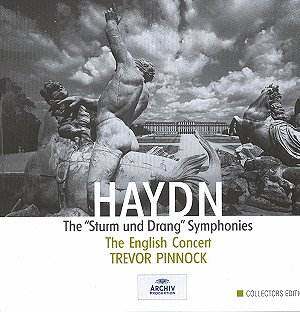Joseph HAYDN
Symphonies Nos 26, 35, 38, 39, 41-52, 58, 59 and 65.
"Sturm and Drang" Symphonies.
 The English Concert directed
by Trevor Pinnock
The English Concert directed
by Trevor Pinnock
Recordings, Henry Wood Hall, London 1988-9 (Reissue)
 DG ARCHIVE COLLECTORS EDITION
463 731-2 [6CDs: Disc 1 [71.09] Disc 2 [50.30] Disc 3 [58.26] Disc 4
[62.22] Disc 5 [62.31] Disc 6
[62.25]]
DG ARCHIVE COLLECTORS EDITION
463 731-2 [6CDs: Disc 1 [71.09] Disc 2 [50.30] Disc 3 [58.26] Disc 4
[62.22] Disc 5 [62.31] Disc 6
[62.25]]
Crotchet
AmazonUK
AmazonUS
Amazon
recommendations

These symphonies are in some ways the most significant and interesting of
those written by Haydn. They were written in 1766 to 1773 when Haydn was
Kapellmeister for the Esterházy family and were first performed at
the summer residence at Esterházy.
Although he had only a small orchestra, he experimented with form and content
of symphony and, unusually for the time, wrote many of them in the minor
key. His range of colour and use of dissonance is striking. This period coincided
with the dramatic and literary movements of that period which were known
as "Sturm and Drang" (Storm and Stress) after a play by Friedrich Klinger.
The pessimism and the drama were taken up by the young Goethe and this movement
also led to the German passion for Shakespeare. There is some doubt about
to what extent his use of minor keys and dramatic effects arose from the
literary movement or from his musical experiments spontaneously.
Trevor Pinnock on this disc uses an orchestra of the same size and composition
as Haydn (up to 34 players). He directs from the harpsichord. The performances
are exemplary, with lively accurate playing, very clear recordings and with
minuets and finales often played at an engagingly fast pace. This sets a
standard by which all Haydn discs should be judged.
Few of these symphonies are as well known as the later London set, but many
of these earlier works are just as interesting and sometimes more arresting.
Symphony No. 48 ("Maria Theresia"), for example, has an opening with rasping
horns which contrasts splendidly with quieter string theme; the adagio has
muted strings with contrasting horn and oboe arpeggios. I was particularly
taken by Symphony No. 51 with its amazing horn parts played superbly here.
The story of the "Farewell" Symphony (No. 45) is well known; with its ever
reducing texture of the music in the last movement, it is a delightful piece
which also sheds light on the character both of Haydn and of the Prince.
With such wonderful music, excellent playing and recording at super bargain
price, the set should not be missed and should be a candidate for inclusion
in every collection.
The set is attractively presented in a strong cardboard box with individual
board sleeves. There is a good booklet which contains an especially interesting
and erudite essay and description of the works by Nicholas Kenyon.
Arthur Baker.

